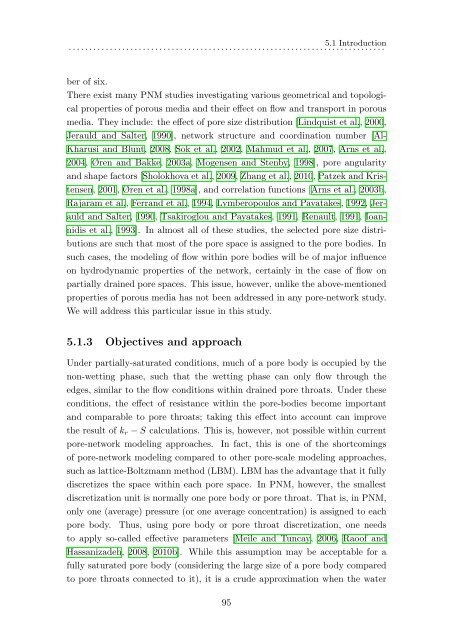download pdf version of PhD book - Universiteit Utrecht
download pdf version of PhD book - Universiteit Utrecht
download pdf version of PhD book - Universiteit Utrecht
Create successful ePaper yourself
Turn your PDF publications into a flip-book with our unique Google optimized e-Paper software.
5.1 Introduction<br />
. . . . . . . . . . . . . . . . . . . . . . . . . . . . . . . . . . . . . . . . . . . . . . . . . . . . . . . . . . . . . . . . . . . . . . . . . . . . .<br />
ber <strong>of</strong> six.<br />
There exist many PNM studies investigating various geometrical and topological<br />
properties <strong>of</strong> porous media and their effect on flow and transport in porous<br />
media. They include: the effect <strong>of</strong> pore size distribution [Lindquist et al., 2000,<br />
Jerauld and Salter, 1990], network structure and coordination number [Al-<br />
Kharusi and Blunt, 2008, Sok et al., 2002, Mahmud et al., 2007, Arns et al.,<br />
2004, Øren and Bakke, 2003a, Mogensen and Stenby, 1998], pore angularity<br />
and shape factors [Sholokhova et al., 2009, Zhang et al., 2010, Patzek and Kristensen,<br />
2001, Øren et al., 1998a], and correlation functions [Arns et al., 2003b,<br />
Rajaram et al., Ferrand et al., 1994, Lymberopoulos and Payatakes, 1992, Jerauld<br />
and Salter, 1990, Tsakiroglou and Payatakes, 1991, Renault, 1991, Ioannidis<br />
et al., 1993]. In almost all <strong>of</strong> these studies, the selected pore size distributions<br />
are such that most <strong>of</strong> the pore space is assigned to the pore bodies. In<br />
such cases, the modeling <strong>of</strong> flow within pore bodies will be <strong>of</strong> major influence<br />
on hydrodynamic properties <strong>of</strong> the network, certainly in the case <strong>of</strong> flow on<br />
partially drained pore spaces. This issue, however, unlike the above-mentioned<br />
properties <strong>of</strong> porous media has not been addressed in any pore-network study.<br />
We will address this particular issue in this study.<br />
5.1.3 Objectives and approach<br />
Under partially-saturated conditions, much <strong>of</strong> a pore body is occupied by the<br />
non-wetting phase, such that the wetting phase can only flow through the<br />
edges, similar to the flow conditions within drained pore throats. Under these<br />
conditions, the effect <strong>of</strong> resistance within the pore-bodies become important<br />
and comparable to pore throats; taking this effect into account can improve<br />
the result <strong>of</strong> k r − S calculations. This is, however, not possible within current<br />
pore-network modeling approaches. In fact, this is one <strong>of</strong> the shortcomings<br />
<strong>of</strong> pore-network modeling compared to other pore-scale modeling approaches,<br />
such as lattice-Boltzmann method (LBM). LBM has the advantage that it fully<br />
discretizes the space within each pore space. In PNM, however, the smallest<br />
discretization unit is normally one pore body or pore throat. That is, in PNM,<br />
only one (average) pressure (or one average concentration) is assigned to each<br />
pore body. Thus, using pore body or pore throat discretization, one needs<br />
to apply so-called effective parameters [Meile and Tuncay, 2006, Rao<strong>of</strong> and<br />
Hassanizadeh, 2008, 2010b]. While this assumption may be acceptable for a<br />
fully saturated pore body (considering the large size <strong>of</strong> a pore body compared<br />
to pore throats connected to it), it is a crude approximation when the water<br />
95

















